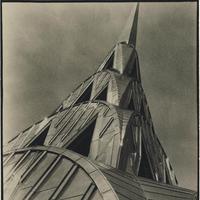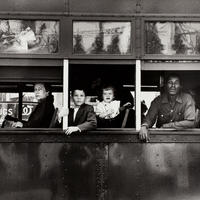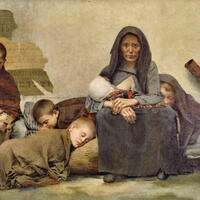More about Margaret Bourke-White
Works by Margaret Bourke-White

Contributor
There is no shortage of badass women featured on this site, but Margaret Bourke-White aka “Maggie the Indestructible” might be queen bee.
You might be thinking, “Hey wait, what about Frida Kahlo? She had a pole basically cut her in half and she still created an incredible body of work and had affairs with all of the greatest artists and politicians of her time. Doesn’t that count for anything?” Yes, it does, but until we find out that Frida was also, "torpedoed in the Mediterranean, strafed by the Luftwaffe (Nazi air force), stranded on an Arctic island, bombarded in Moscow, and pulled out of the Chesapeake when her chopper crashed,” Maggie still wins.
Bourke-White’s life stories seem like they couldn’t possibly be true, but as her medium was photography, and this was before Photoshop was a thing, there is undeniable proof that she did everything she said she did. For instance, being the last person to interview Gandhi before he was assassinated seems farfetched, but Maggie took one of the most famous pictures of him in front of his spinning wheel. Similarly, being there when Buchenwald, the Nazi concentration camp was freed, and when German citizens were forced to walk through to witness the atrocities that had taken place seems too dramatic an event to be witnessed. But again, some of her most iconic photographs were of emaciated bodies piled high on a cart as perfectly healthy sheeple walked by.
Throughout her career, Bourke-White really had a knack for being in the right place at the right time, if you consider highly dangerous, war-torn areas at the peak of conflict the right place and the right time. On one assignment, she was the only westerner allowed in the Soviet Union in 1941 during the Battle of Moscow and took one of the only photographs in existence of Stalin smiling. She was on the front lines during the Korean War, went a mile underground to photograph gold and diamond miners in South Africa and climbed a gargoyle on New York’s Chrysler Building.
And who, you may ask, sent her on all of these life-threatening missions? It was Time Magazine, because of course she was their fav photographer and her photo was on the cover of the very first issue. The badassery only stopped when Parkinson’s Disease made it impossible for her to take pictures. Even then she faced her fate with fierceness and poise. She said, “the beauty of the past belongs to the past.” An apt motto for a photographer.
Sources
- "Margaret Bourke-White | Biography." GALLERY M. Web. 28 Aug. 2017.
- Whitman, Alden. "Margaret Bourke‐White, Photo‐Journalist, Is Dead." Nytimes.com. N.p., 1971. Web. 28 Aug. 2017.
- Cosgrove, Ben. "Behind The Picture: The Liberation Of Buchenwald, April 1945." Time.com. N.p., 2013. Web. 28 Aug. 2017.
- Ronk, Liz, and Olivia B. Waxman. "See The Classic Cameras Used By LIFE's First Female Staff Photographer." Time.com. N.p., 2016. Web. 28 Aug. 2017.

Sr. Contributor
Margaret Bourke-White embodied the idea of girl power before celebrating strong women was even a thing.
With photography as a relatively new medium, Bourke-White was poised to break down many barriers related to the art form, all while being a woman. Not even two decades since women in the United States gained the right to vote, she was hard at work establishing photography as a field in which women could do just as much as men could, if not more.
Regardless of her gender, Bourke-White was the first to do many things. Having belonged to a movement of photographers who admired modernism and industrialization reminiscent of Fernand Léger’s machine obsession, Bourke-White developed a focus on all things American and industrial. She developed a unique style that appreciated modern, industrial forms and utilized these objects for art photography. This jived with the vision of Henry Luce, the founder of Fortune magazine, who asked Bourke-White to be the magazine’s first staff photographer in 1929.
As you can imagine, this job gave Margaret some serious clout, and this was only the beginning. Staying on brand was easy – there was a lot happening on the global scene. Luce sent Bourke-White to the Soviet Union in 1930, making her the first Western photographer to take pictures of the country’s industry. At this time, Stalin was transforming the Soviet Union into an industrial power that would soon threaten the United States. Bourke-White captured images of Soviet factory workers and the horrible conditions that plagued millions; she even made a portrait of the dictator’s great aunt.
When publishing magnate Luce was ready to begin his next big project in 1936, you best believe that Bourke-White was on the short list of photographers to call. This wasn’t some lame spinoff of Fortune magazine. No, this was an even bigger undertaking – the start of Life magazine. Luce assigned the fearless female to travel to a small settlement near Billings, Montana to photograph the construction of the Fort Peck Dam, which is still the largest earth-filled dam in the world. The photograph that she took became the very first cover for Life.
Bourke-White continued to shoot for Life, going where few Americans were willing to go. In 1943, Bourke-White became the first woman to take part in an American bombing mission, when US forces bombed a Tunisian airport during World War II. After the war ended in 1945, Bourke-White continued to travel with the US army as they began liberating German concentration camps. She and other Life staff photographers were among the first people to capture the atrocities that had been committed inside these death camps.
While certainly known for her firsts, Bourke-White is also known for a last. She captured a peaceful image of Gandhi seated beside his charkha, or spinning wheel, and reading the news. This would be the final photograph taken of the leader before his assassination. Gandhi urged his fellow Indians to make their own clothing rather than buy British imports, and his association with spinning thread was so strong that Bourke-White had to learn the craft before she could meet him.
All in all, Bourke-White was a fearless and determined woman who paved the way for female photographers and journalists.
Sources
- Abbaspour, Mitra. “Margaret Bourke-White.” The Museum of Modern Art. 2014. https://www.moma.org/artists/712?locale=en. Accessed August 28, 2017.
- Cosgrove, Ben. “Behind the Picture: The Liberation of Buchenwald, April 1945.” Time. October 10, 2013. http://time.com/3638432/behind-the-picture-the-liberation-of-buchenwald…. Accessed August 28, 2017.
- Cosgrove, Ben. “LIFE’s First-Ever Cover Story: Building the Fort Peck Dam, 1936.” Time. November 16, 2012. http://time.com/3764198/lifes-first-ever-cover-story-building-the-fort-…. Accessed August 28, 2017.
- Dickie, Chris. Icons of Culture: Photography, The 50 most influential photographers of all time. London: Elwin Street Limited, 2009.
- Hirsch, Robert. Seizing the Light: A History of Photography. Boston: McGraw-Hill Higher Education, 2000.
- History.com. “19th Amendment.” History.com. http://www.history.com/topics/womens-history/19th-amendment. Accessed August 28, 2017.
- Hostetler, Lisa. “Margaret Bourke-White.” Archive. International Center of Photography. https://www.icp.org/browse/archive/constituents/margaret-bourke-white?a…. Accessed August 28, 2017.
- Pollack, Kira, and Paul Moakley. “Gandhi and the Spinning Wheel, 1946.” 100 Photos. Time. http://100photos.time.com/photos/margaret-bourke-white-gandhi-spinning-…. Accessed August 28, 2017.
Featured Content
Here is what Wikipedia says about Margaret Bourke-White
Margaret Bourke-White (/ˈbɜːrk/; June 14, 1904 – August 27, 1971) was an American photographer and documentary photographer. She was the first foreign photographer permitted to take pictures of Soviet industry under the Soviets' first five-year plan, was the first American female war photojournalist, and took the photograph (of the construction of Fort Peck Dam) that became the cover of the first issue of Life magazine.
Check out the full Wikipedia article about Margaret Bourke-White















